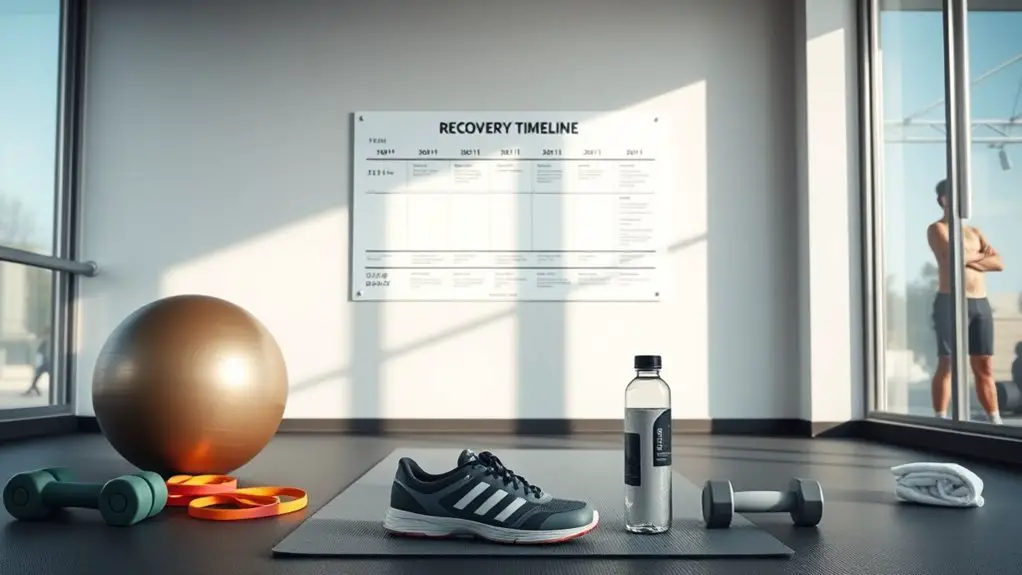How to Get Back Into Gym Training After Surgery

To get back into gym training after surgery, first consult your healthcare provider about your recovery phase and any restrictions. Start with gentle movements like walking and stretching, focusing on gradual improvement. Set realistic fitness goals that accommodate your current capabilities. As you progress, gradually increase intensity and duration, using a systematic approach. Remember to prioritize nutrition, hydration, and rest. This supportive strategy guarantees a safe return to training while setting you up for long-term success. More on effective steps awaits you.
Understanding Your Surgery and Recovery Timeline

When you undergo surgery, understanding your recovery timeline is essential to safely resuming your gym training. Different surgery types, such as orthopedic or abdominal procedures, can greatly influence your recovery phases. Typically, the first phase involves rest and healing, often lasting from a few days to several weeks. During this time, focusing on nutrition and light mobility is critical.
As you move into the second phase, which may begin weeks post-surgery, you can gradually introduce gentle exercises, always honoring your body’s signals. This phase emphasizes rebuilding strength and flexibility without causing strain.
Finally, the third phase allows for a more aggressive return to your gym routine, typically ranging from several weeks to months after surgery, depending on your individual healing process. Throughout, it’s essential to listen to your body and adjust your training intensity accordingly, ensuring a safe and effective return to fitness.
Consult With Your Healthcare Provider
Before diving back into your gym training, it’s vital to consult with your healthcare provider to guarantee you’re ready for a safe return. This step is important for discussing any post-surgery precautions that may apply to you. Your provider can assess your recovery and determine if you can start rehabilitation exercises or if you need more time.
Here’s a table to help you understand what to discuss:
| Topic | Details |
|---|---|
| Recovery Status | Evaluate if you’re healing properly |
| Activity Restrictions | Identify any movements to avoid |
| Rehabilitation Exercises | Recommendations for safe exercises to begin |
Start With Gentle Movements and Stretching

As you shift back into gym training, it’s important to start with gentle movements and stretching to ease your body into a routine. Begin with light walking to gradually increase circulation without overwhelming your muscles. Aim for short sessions, allowing your body to adapt.
Incorporating gentle yoga can enhance flexibility and promote relaxation. Focus on poses that emphasize deep breathing and slow, controlled movements; these will help you reconnect with your body while minimizing stress on any healing areas.
Listen to your body during these activities. If you experience any discomfort or pain, ease off and adjust your approach. Stretching is vital; it improves range of motion and prevents stiffness, so dedicate time to stretch major muscle groups after your light walking or yoga sessions. Starting with these gentle movements prepares your body for more intense workouts in the future, fostering a safe and effective return to your fitness journey.
Set Realistic Fitness Goals
Setting realistic fitness goals is essential for a successful return to gym training after surgery. Begin by evaluating your current physical capabilities and understanding your limitations. This helps in setting benchmarks that reflect what you can safely achieve. Instead of aiming for rapid progress, focus on gradual improvements.
Adjusting expectations based on your recovery stage is vital; this isn’t a race. For instance, if you’re rebuilding strength, aim to increase weights or repetitions incrementally rather than pushing too hard too soon.
Document your progress to keep track of achievements, no matter how small, as they can provide motivation. Remember, your goals should be specific, measurable, attainable, relevant, and time-bound (SMART). This approach not only fosters a sense of accomplishment but also helps in maintaining a positive mindset during your recovery journey. Stay patient and kind to yourself as you work towards regaining your fitness.
Gradually Increase Intensity and Duration

Once you’ve established a foundation of realistic fitness goals, it’s crucial to gradually increase the intensity and duration of your workouts. This process, known as progressive overload, helps your body adapt and build strength without risking injury. Start with manageable increments—whether it’s adding a few extra reps, increasing weights, or extending workout time by just a few minutes.
Training periodization is also essential; this involves varying your training intensity and volume over time to maximize gains and prevent plateaus. For instance, you might dedicate a few weeks to endurance, followed by a phase focused on strength. Always listen to your body and adjust your progression accordingly—if you experience pain or fatigue, scale back. Remember, gradual increases will not only enhance your performance but also foster long-term adherence to your fitness journey. Skipping the gym for two weeks can lead to decreased strength and endurance levels, so prioritize consistency and patience as you work toward your goals.
Focus on Nutrition and Hydration
While it may be tempting to focus solely on your workouts, paying attention to nutrition and hydration is equally essential for a successful return to gym training after surgery. Proper nutrition aids in recovery and muscle building, while hydration strategies support overall performance and joint health. Implementing nutrient timing can further enhance your results.
Balancing workouts with proper nutrition and hydration is crucial for effective recovery and optimal performance post-surgery.
Consider the following strategies:
- Prioritize protein intake to support muscle repair.
- Include complex carbohydrates for sustained energy levels.
- Stay hydrated throughout the day, aiming for at least half your body weight in ounces.
- Use electrolytes during intense workouts to maintain balance.
- Plan meals around your training schedule to optimize nutrient absorption.
Incorporate Rest and Recovery Days

As you reintroduce yourself to gym training after surgery, it is crucial to prioritize rest and recovery days to prevent overtraining and support healing. Incorporating these days into your routine not only enhances your performance but also maximizes the rest benefits, allowing your body to repair and rebuild.
Here are some effective recovery techniques to evaluate:
| Recovery Technique | Description |
|---|---|
| Active Recovery | Light activities like walking or yoga to promote blood flow. |
| Sleep Hygiene | Ensuring 7-9 hours of quality sleep per night for peak recovery. |
| Hydration | Maintaining fluid levels to support muscle function and recovery. |
| Stretching and Foam Rolling | Easing muscle tension and improving flexibility. |
Track Your Progress and Celebrate Milestones
Tracking your progress and celebrating milestones fosters a sense of accomplishment and motivation in your recovery journey. By keeping a progress journal, you can document your workouts, improvements, and any adjustments needed. This practice not only helps you stay accountable but also allows you to reflect on your growth throughout the rehabilitation process.
To enhance your recovery experience, consider the following strategies:
- Set specific, measurable goals to track your achievements.
- Regularly review your progress journal to identify trends and areas for improvement.
- Celebrate small victories with milestone rewards, such as new workout gear or a spa day.
- Share your achievements with friends or a support group for added encouragement.
- Adjust your goals as needed to keep them challenging yet achievable.
Frequently Asked Questions
Can I Return to My Previous Workout Routine Immediately After Recovery?
You can’t return to your previous workout routine immediately after recovery. It’s essential to allow your body time to heal properly. Instead, focus on progressive overload by gradually increasing the intensity of your workouts. Start with low-impact exercises and slowly build up strength and endurance. Listen to your body and don’t rush the process; a gradual increase in workload will help prevent injury and guarantee long-term success in your fitness journey.
What Types of Exercises Should I Avoid Post-Surgery?
After surgery, you should avoid high-impact exercises, as they can stress your healing body. Activities like running or jumping can exacerbate any vulnerabilities. Additionally, steer clear of torso twisting movements, which may put undue strain on surgical sites and hinder recovery. Focus on low-impact options and consult your healthcare provider for a tailored plan that respects your healing process while gradually reintroducing movement and strength into your routine.
How Can I Prevent Re-Injury While Exercising?
To prevent re-injury while exercising, focus on injury prevention strategies. Start with low-impact activities and gradually increase intensity. Use exercise modifications to guarantee you’re not overexerting yourself. Pay attention to your body; listen for any signs of discomfort or pain, and adjust accordingly. Incorporating proper warm-ups and cool-downs can also help. Finally, consider working with a qualified trainer to tailor a safe program that aligns with your recovery goals.
When Is It Safe to Start Strength Training Again?
Like a phoenix rising from the ashes, you’re enthusiastic to start strength training again. Typically, it’s safe to resume once you’ve cleared a strength assessment with your healthcare provider, ensuring you’re within your rehabilitation timeline. Listen to your body; gradual progression is key. Start with light weights and maintain proper form. If you experience pain, it’s crucial to pull back and consult your provider. Patience now will lead to a stronger comeback later.
Is It Normal to Feel Pain During Rehabilitation Exercises?
It’s common to experience some rehabilitation pain during exercises, especially if you’re adjusting to new movements. However, it’s essential to differentiate between normal discomfort and sharp pain that indicates an issue. Consider implementing exercise modifications to reduce strain on affected areas while still promoting recovery. Always listen to your body, and if pain persists or worsens, consult your healthcare provider to guarantee you’re progressing safely and effectively in your rehabilitation journey.





